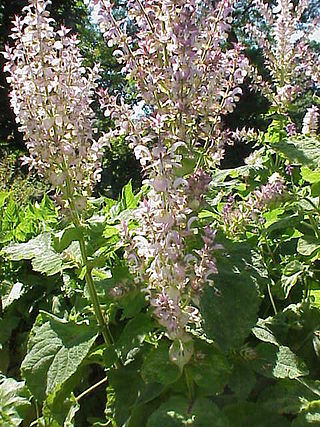
Salvia sclarea, the clary or clary sage, is a biennial (short-lived) herbaceous perennial in the genus Salvia. It is native to the northern Mediterranean Basin and to some areas in north Africa and Central Asia. The plant has long been cultivated as an herb and is currently grown for its essential oil.
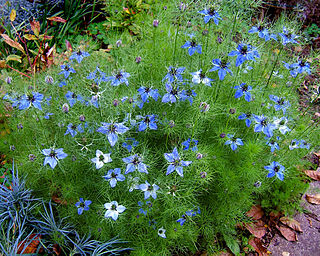
Nigella damascena, love-in-a-mist, or devil in the bush, is an annual garden flowering plant, belonging to the buttercup family Ranunculaceae. It is native to southern Europe, north Africa and southwest Asia, where it is found on neglected, damp patches of land.

Ipomoea purpurea, the common morning-glory, tall morning-glory, or purple morning glory, is a species in the genus Ipomoea, native to Mexico and Central America.

Salvia sonomensis is a low-growing perennial plant that is endemic to California.

Hemerocallis fulva, the orange day-lily, tawny daylily, corn lily, tiger daylily, fulvous daylily, ditch lily or Fourth of July lily, is a species of daylily native to Asia. It is very widely grown as an ornamental plant in temperate climates for its showy flowers and ease of cultivation. It is not a true lily in the genus Lilium, but gets its common name from the superficial similarity of its flowers to Lilium and from the fact that each flower lasts only one day.

Salvia pratensis, the meadow clary or meadow sage, is a species of flowering plant in the family Lamiaceae, native to Europe, western Asia and northern Africa. The Latin specific epithet pratensis means "of meadows", referring to its preferred habitat. It also grows in scrub edges and woodland borders.
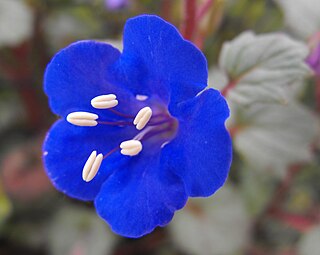
Phacelia campanularia is a species of flowering plant in the borage family, Boraginaceae, known by the common names desertbells, desert bluebells, California-bluebell, desert scorpionweed, and desert Canterbury bells. Its true native range is within the borders of California, in the Mojave and Sonoran Deserts, but it is commonly cultivated as an ornamental plant and it can be found growing elsewhere as an introduced species.

Symphyotrichum laeve is a flowering plant native to Canada, the United States, and Coahuila (Mexico). It has the common names of smooth blue aster, smooth aster, smooth-leaved aster, glaucous Michaelmas-daisy and glaucous aster.

Anaphalis margaritacea, commonly known as the western pearly everlasting or pearly everlasting, is an Asian and North American species of flowering perennial plant in the family Asteraceae.

Lathyrus sylvestris, the flat pea or narrow-leaved everlasting-pea, is a species of flowering plant in the pea and bean family Fabaceae. It is native to parts of Africa, Europe, and Asia.
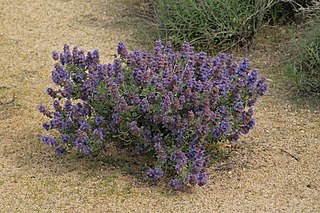
Salvia dorrii, the purple sage, Dorr's sage, fleshy sage, mint sage, or tobacco sage, is a perennial spreading shrub in the family Lamiaceae. It is native to mountain areas in the western United States and northwestern Arizona, found mainly in the Great Basin and southward to the Mojave Desert, growing in dry, well draining soils.
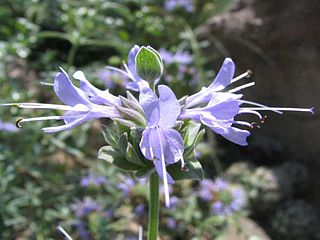
Salvia clevelandii, the fragrant sage, blue sage, Jim sage, Cleveland sage, and Cleveland's blue sage is a perennial plant of family Lamiaceae native to Southern California and northern Baja California, growing below 900 m (3,000 ft) elevation in California coastal sage and chaparral habitat. The plant was named in 1874 by Asa Gray, honoring plant collector Daniel Cleveland.
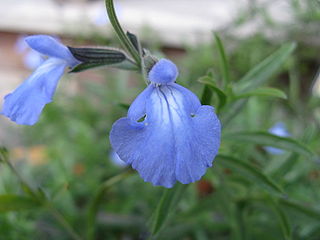
Salvia azurea, the azure blue sage, azure sage, blue sage or prairie sage, is a herbaceous perennial in the genus Salvia that is native to Central and Eastern North America.
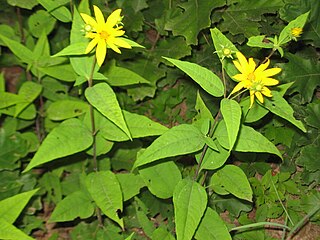
Helianthus divaricatus, commonly known as the rough sunflower, woodland sunflower, or rough woodland sunflower, is a North American species perennial herb in the family Asteraceae. It is native to central and eastern North America, from Ontario and Quebec in the north, south to Florida and Louisiana and west to Oklahoma and Iowa.

Dryopteris cristata is a perennial species of fern native to wetlands throughout the Northern Hemisphere. It is known as crested wood fern, crested buckler-fern or crested shieldfern. This plant is a tetraploid species of hybrid origin, one parent being Dryopteris ludoviciana and the other being the unknown, apparently extinct species, dubbed Dryopteris semicristata, which is also one of the presumed parents of Dryopteris carthusiana. D. cristata in turn is one of the parents of Dryopteris clintoniana, another fern of hybrid origin.

Salvia farinacea, the mealycup sage, or mealy sage, is a herbaceous perennial native to Nuevo León, Mexico and parts of the United States including Texas and Oklahoma. Violet-blue spikes rest on a compact plant of typically narrow salvia-like leaves; however, the shiny leaves are what set this species apart from most other Salvia, which bear velvety-dull leaves.

Solidago speciosa, the showy goldenrod, is a North American species of flowering plants in the family Asteraceae. It grows in the province of Ontario in central Canada, as well as in the eastern and central United States.
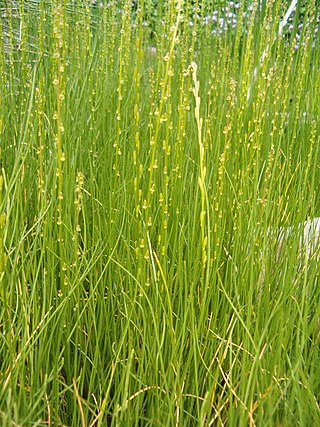
Triglochin palustris or marsh arrowgrass is a species of flowering plant in the arrowgrass family Juncaginaceae. It is found in damp grassland usually on calcareous soils, fens and meadows. The species epithet palustris is Latin for "of the marsh" and indicates its common habitat. It has a circumboreal distribution, occurring throughout northern parts of the Northern Hemisphere. It can be found locally in the British Isles especially the north.

Salvia ballotiflora is a species of flowering plant in the mint family, Lamiaceae, that is native to Texas in the United States as well as northeastern and central Mexico. Common names include shrubby blue sage and mejorana.
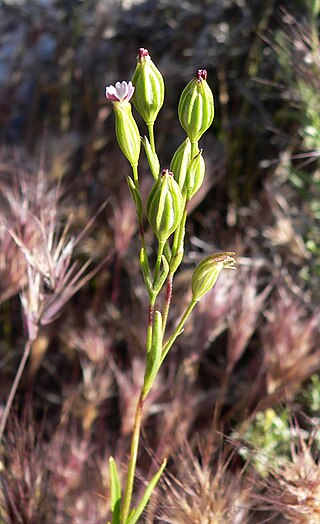
Silene antirrhina is a species of flowering plant in the family Caryophyllaceae known by the common names sleepy silene and sleepy catchfly. It is native to the Americas and has been introduced to Europe.





















